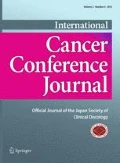Abstract
Cytotoxic chemotherapy after exposure to nivolumab (nivo), an anti-programmed death-1 (PD-1) antibody, has been associated with good response compared with historical data in various cancers including head and neck squamous cell carcinoma (HNSCC). In a previous report, different chemotherapy regimens were used before and after treatment with nivo. This HNSCC case is the first report of a good response when the same cytotoxic chemotherapy regimen was used before and after nivo. In addition, the efficacy of anti-epidermal growth factor receptor antibody after nivo treatment may be better than without exposure to nivo.

Similar content being viewed by others
References
Ferris RL, Blumenschein G Jr, Fayette J et al (2016) Nivolumab for recurrent squamous-cell carcinoma of the head and neck. N Engl J Med 375:1856–1867
Daste A, de Mones E, Digue L et al (2017) Immunotherapy in head and neck cancer: need for a new strategy? Rapid progression with nivolumab then unexpected response with next treatment. Oral Oncol 64:e1–e3
Schvartsman G, Peng SA, Bis G et al (2017) Response rates to single-agent chemotherapy after exposure to immune checkpoint inhibitors in advanced non-small cell lung cancer. Lung Cancer 112:90–95
Reck M, Rodríguez-Abreu D, Robinson AG et al (2019) Updated analysis of KEYNOTE- 024: pembrolizumab versus platinum-based chemotherapy for advanced non-small-cell lung cancer with PD-L1 tumor proportion score of 50% or greater. J Clin Oncol. 8:JCO1800149. https://doi.org/10.1200/JCO.18.00149
Leger PD, Rothschild S, Castellanos E et al (2017) Response to salvage chemotherapy following exposure to immune checkpoint inhibitors in patients with non-small cell lung cancer. J Clin Oncol 35 suppl:abstr 9084
Peng J, Hamanishi J, Matsumura N et al (2015) Chemotherapy induces programmed cell death-ligand 1 overexpression via the nuclear factor-κB to foster an immunosuppressive tumor microenvironment in ovarian cancer. Cancer Res 75:5034–5045
Zitvogel L, Apetoh L, Ghiringhelli F, Kroemer G (2008) Immunological aspects of cancer chemotherapy. Nat Rev Immunol 8:59–73
Carson WE III, Shapiro CL, Crespin TR, Thornton LM, Andersen BL (2004) Cellular immunity in breast cancer patients completing taxane treatment. Clin Cancer Res 10:3401–3409
Mallick P, Basu S, Moorthy B, Ghose R (2017) Role of toll-like receptor 4 in drug-drug interaction between paclitaxel and irinotecan in vitro. Toxicol In Vitro 41:75–82
Roy A, Singh MS, Upadhyay P, Bhaskar S (2013) Nanoparticle mediated co-delivery of paclitaxel and a TLR-4 agonist results in tumor regression and enhanced immune response in the tumor microenvironment of a mouse model. Int J Pharm 445:171–180
Agero AL, Dusza SW, Benvenuto-Andrade C et al (2006) Dermatologic side effects associated with the epidermal growth factor receptor inhibitors. J Am Acad Dermatol 55:657
Stintzing S, Kapaun C, Laubender RP et al (2013) Prognostic value of cetuximab-related skin toxicity in metastatic colorectal cancer patients and its correlation with parameters of the epidermal growth factor receptor signal transduction pathway: results from a randomized trial of the GERMAN AIO CRC Study Group. Int J Cancer 132:236
Petrelli F, Borgonovo K, Barni S (2013) The predictive role of skin rash with cetuximab and panitumumab in colorectal cancer patients: a systematic review and meta-analysis of published trials. Target Oncol 8:173
Hitt R, Irigoyen A, Cortes-Funes H et al (2012) Phase II study of the combination of cetuximab and weekly paclitaxel in the first-line treatment of patients with recurrent and/or metastatic squamous cell carcinoma of head and neck. Ann Oncol 23:1016–1022
Jie HB, Srivastava RM, Argiris A et al (2017) Increased PD-1+ and TIM-3+ TILs during cetuximab therapy inversely correlate with response in head and neck cancer patients. Cancer Immunol Res 5:408–416
Bonomo P, Desideri I, Loi M et al (2018) Anti PD-L1 DUrvalumab combined with Cetuximab and RadiOtherapy in locally advanced squamous cell carcinoma of the head and neck: a phase I/II study (DUCRO). Clin Transl Radiat Oncol 9:42–47
Funding
None of the authors have financial disclosures or funding support.
Author information
Authors and Affiliations
Corresponding author
Ethics declarations
Ethical approval
All procedures performed in study involving human participant was in accordance with the ethical standards of the institutional and/or national research committee and with the 1964 Helsinki Declaration and its later amendments or comparable ethical standards.
Conflict of interest
None of the authors have conflicts of interest to declare.
Informed consent
Informed consent was obtained from a participant included in the study.
Additional information
Publisher’s Note
Springer Nature remains neutral with regard to jurisdictional claims in published maps and institutional affiliations.
About this article
Cite this article
Koyama, T., Nomura, M., Keitaro, D. et al. Re-introducing the same chemotherapy after exposure to anti-PD-1 therapy. Int Canc Conf J 8, 86–88 (2019). https://doi.org/10.1007/s13691-019-00360-y
Received:
Accepted:
Published:
Issue Date:
DOI: https://doi.org/10.1007/s13691-019-00360-y


